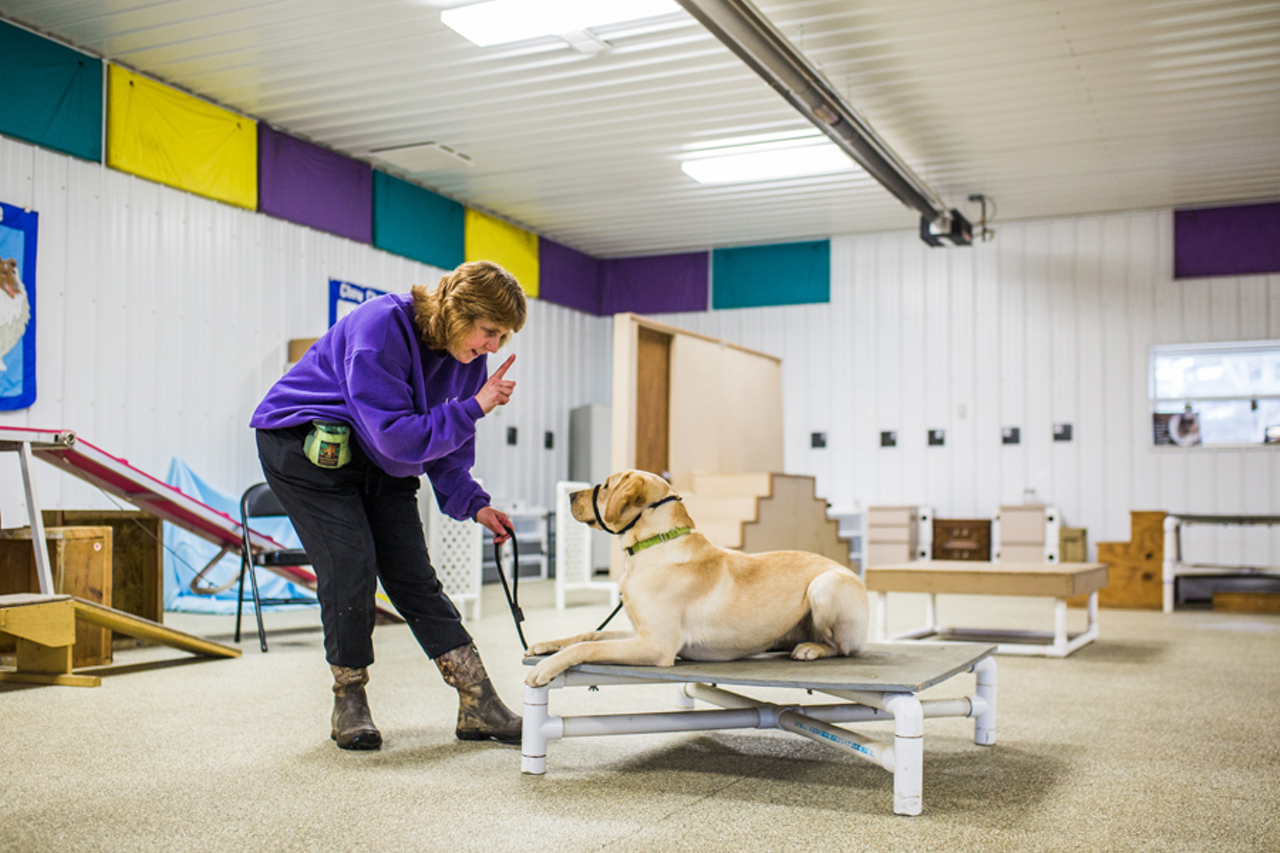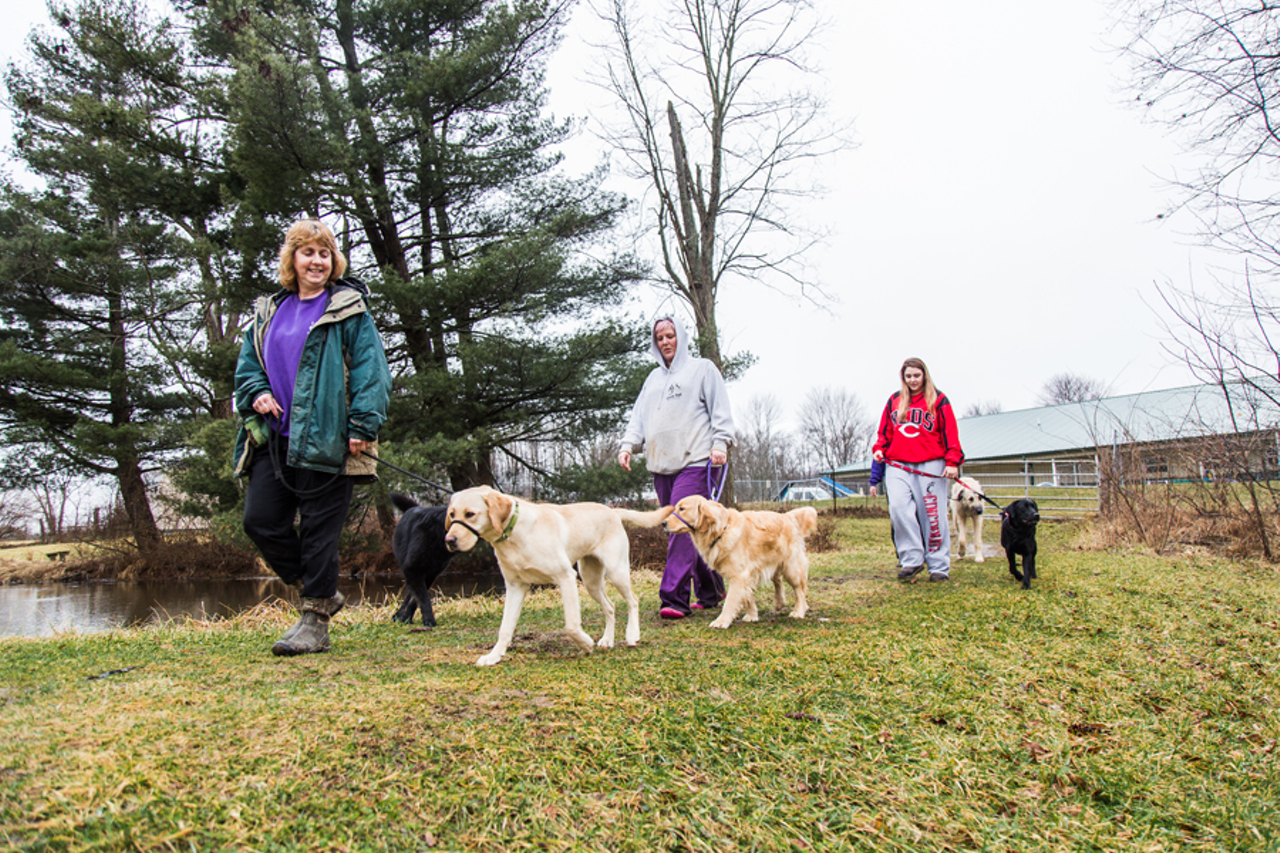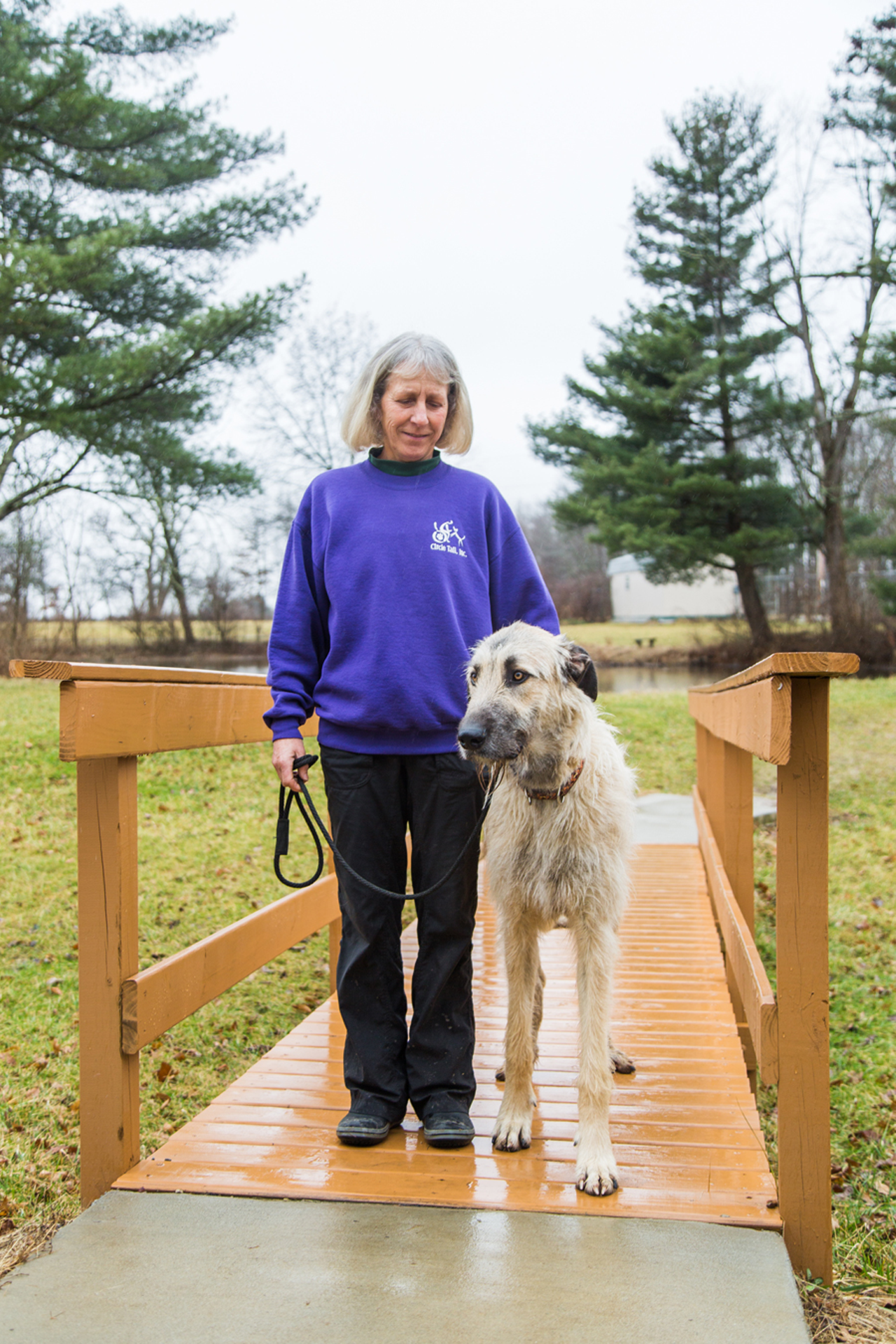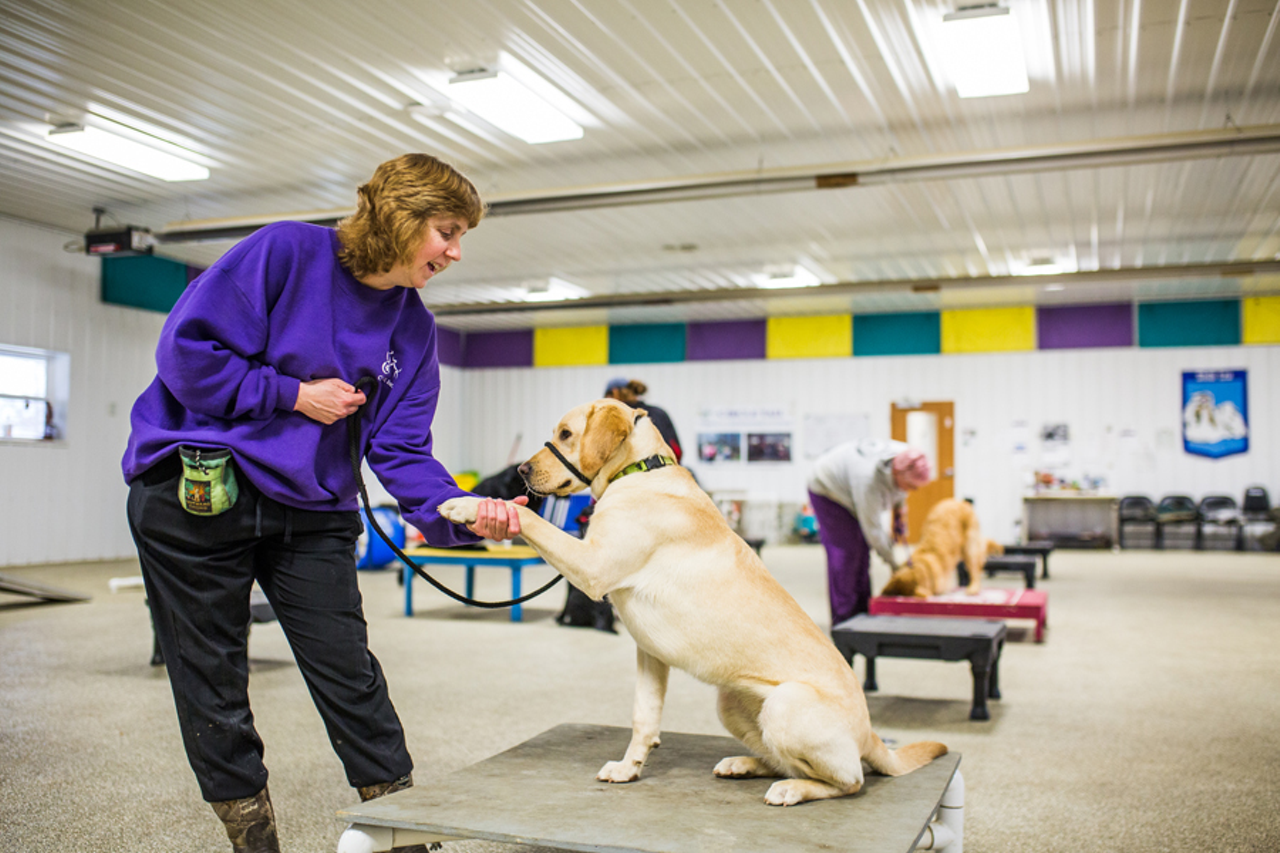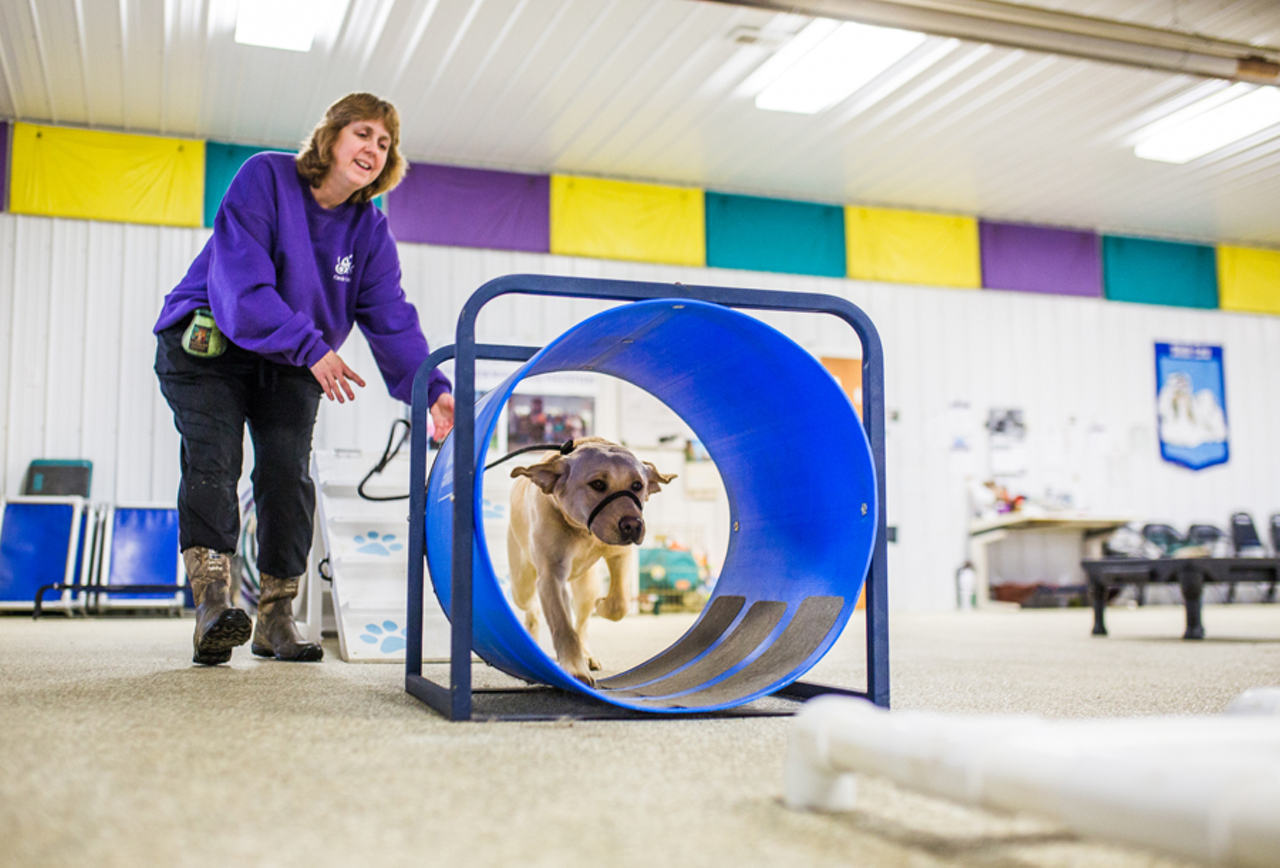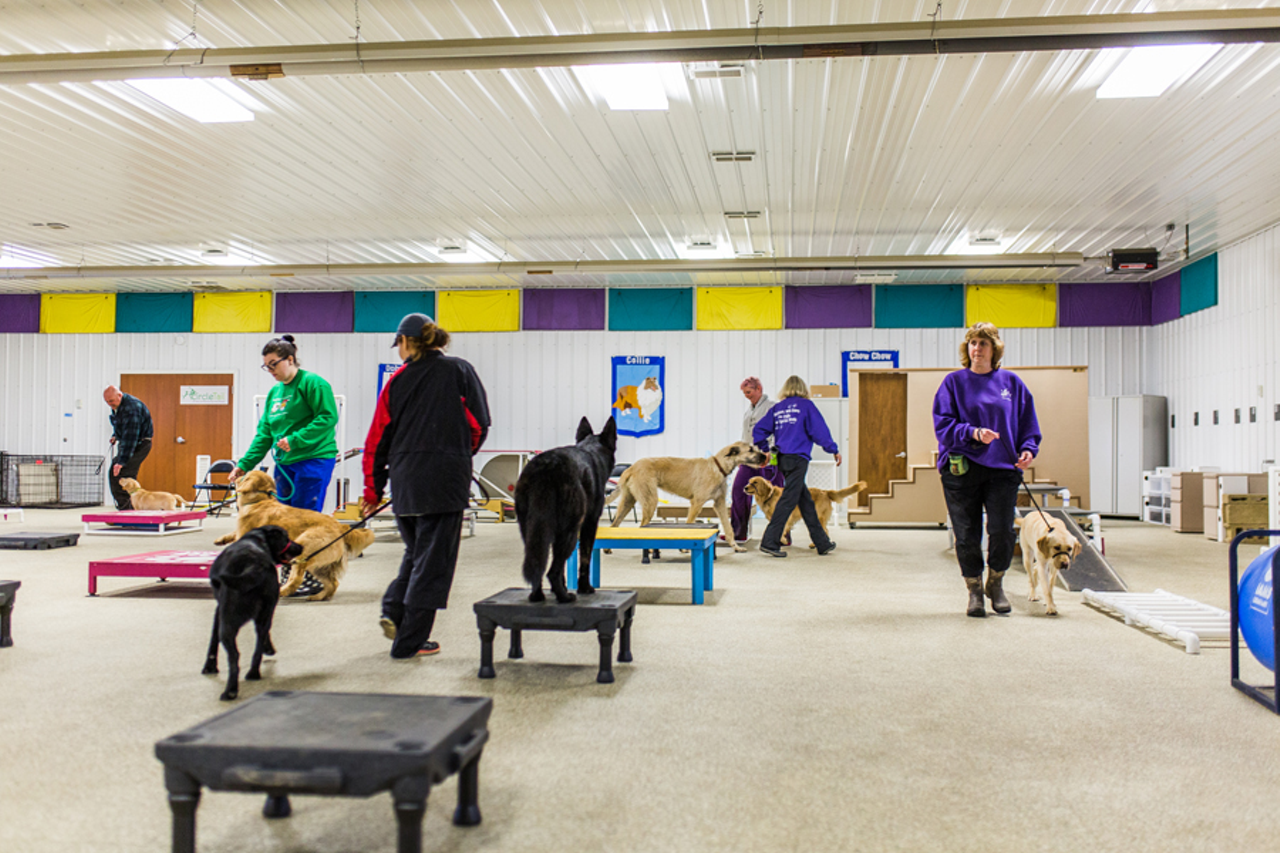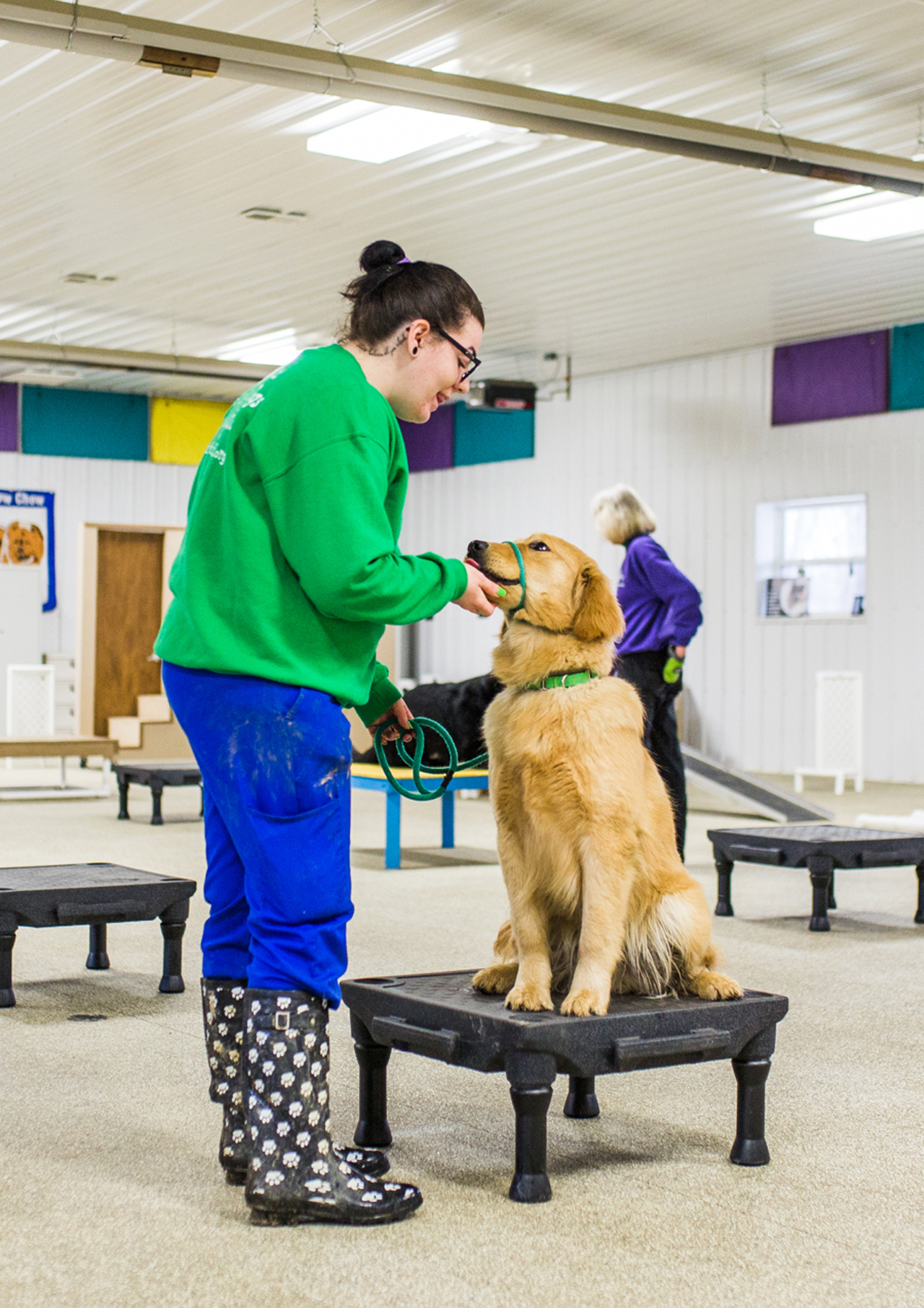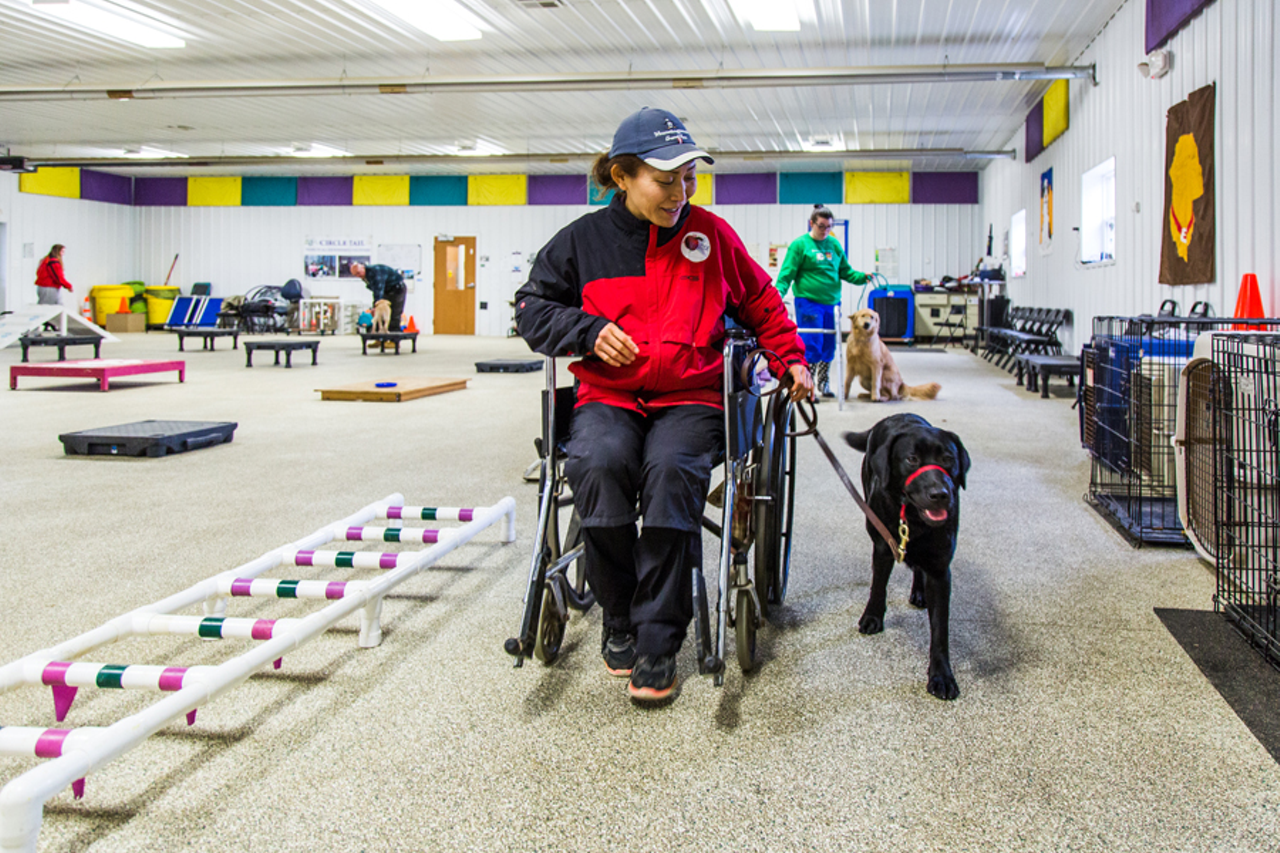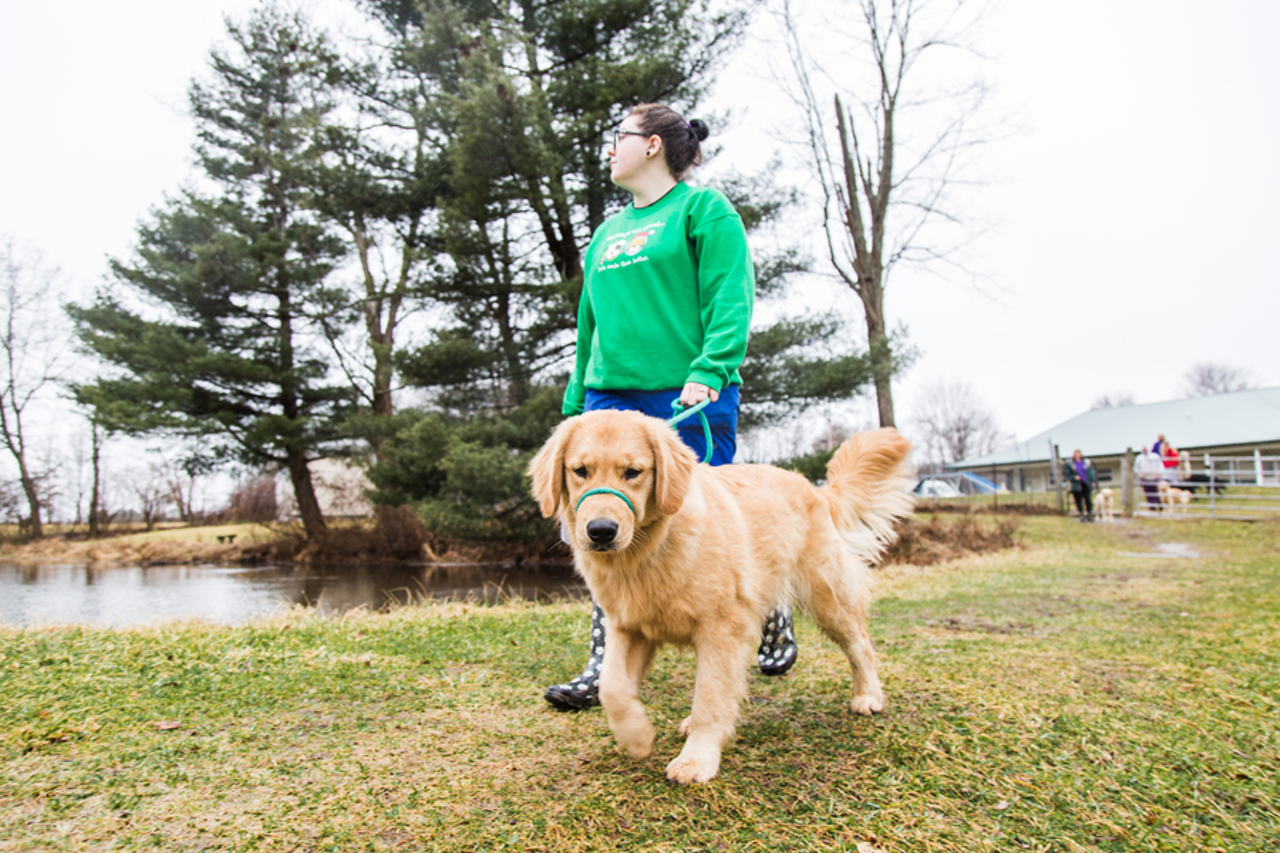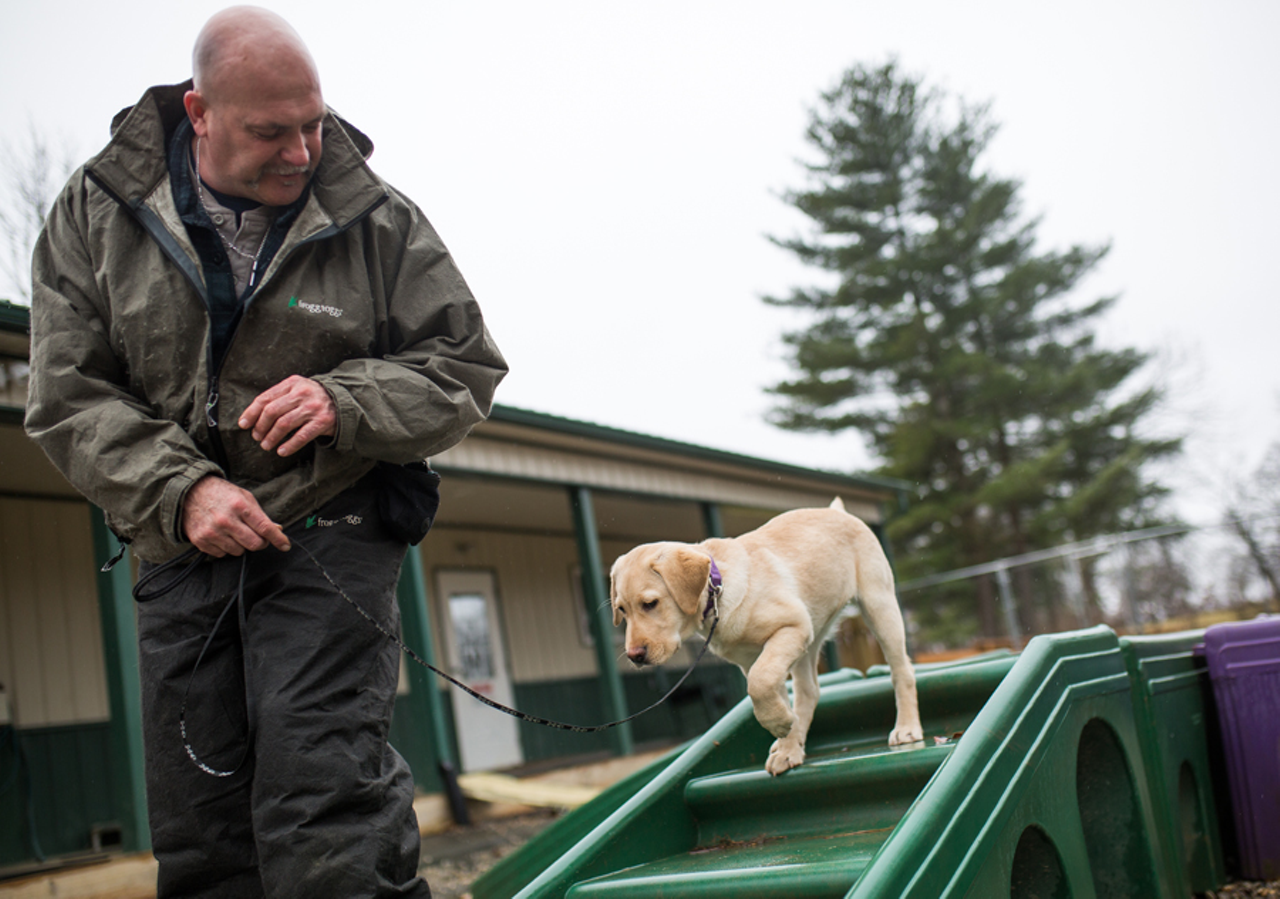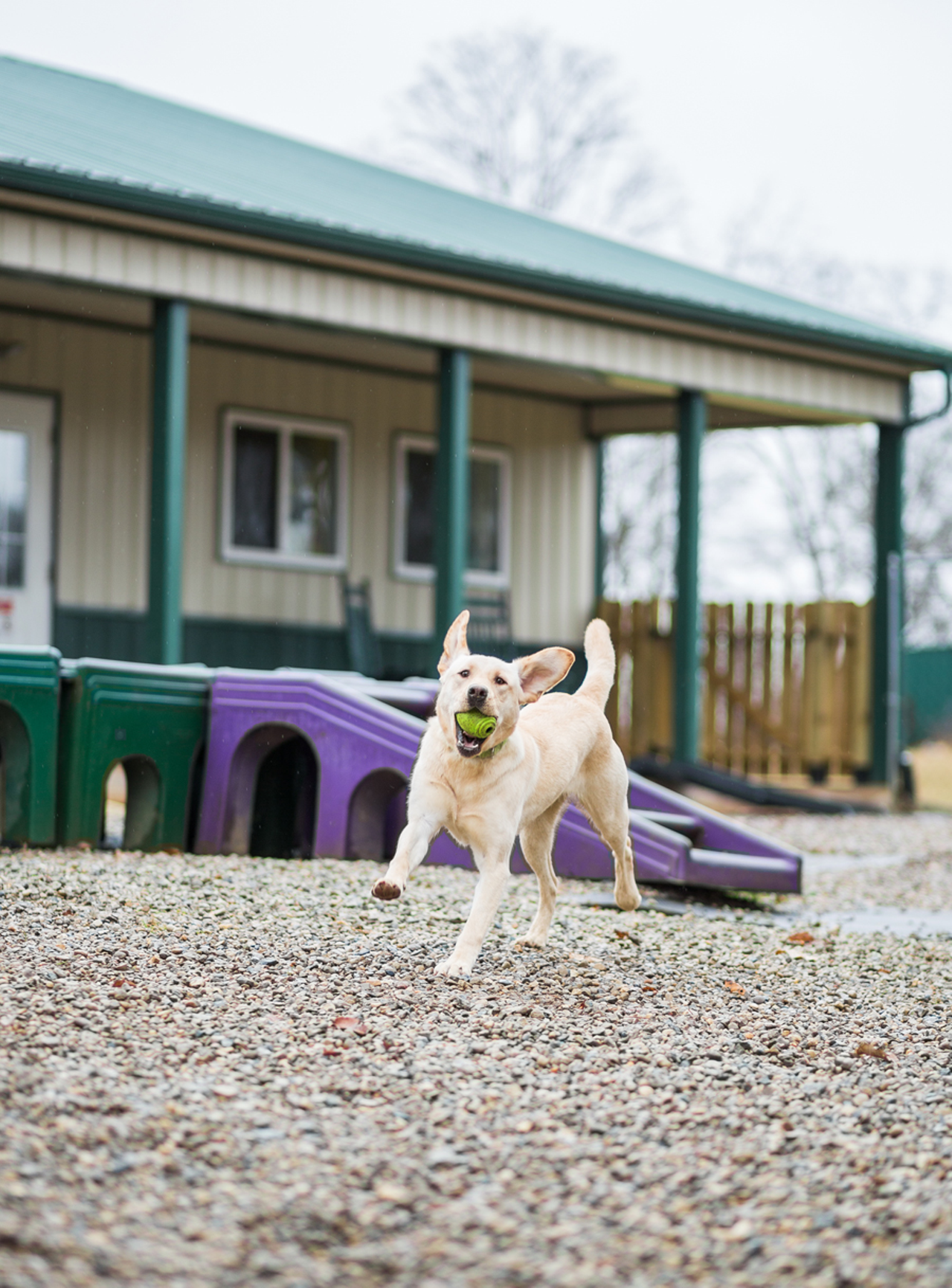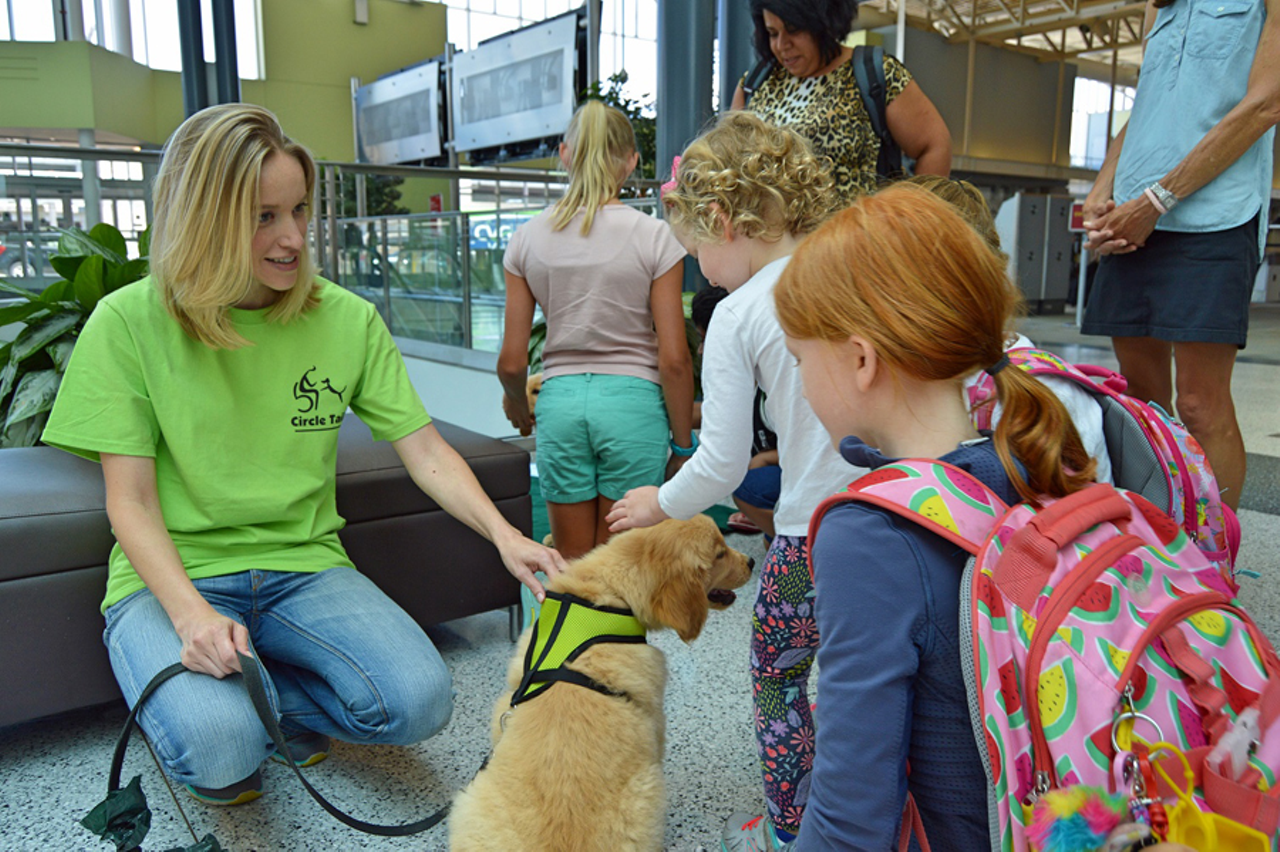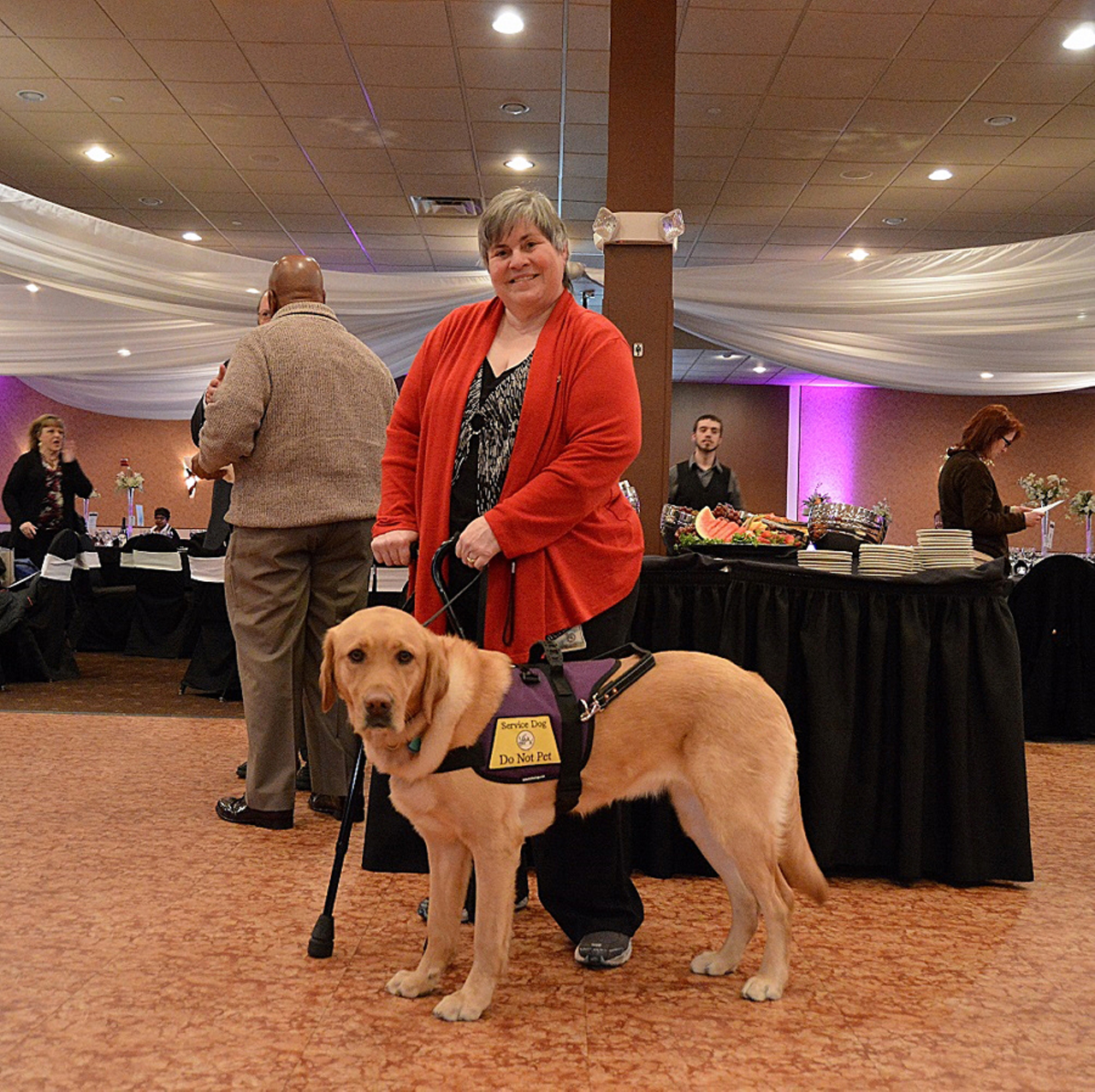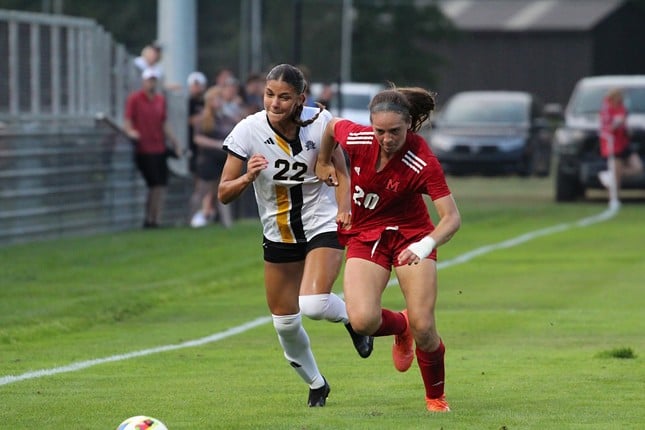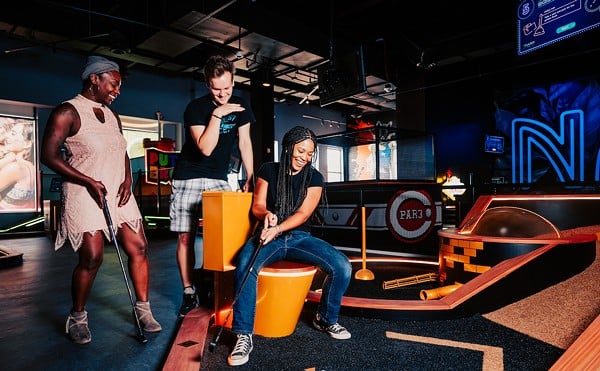Fifteen years ago, Kathleen Putman, a dog groomer of more than 40 years, was living in Dallas and in the midst of training for a triathlon. She was riding her bike to work on a brisk September morning when she was struck by a car, leaving her with a torn aorta, a broken hip and shoulder and a subdural hematoma — a collection of blood outside her brain.
“I had multiple serious injuries,” she says. “They told my family that if I survived, I would be a quadriplegic. But the spinal chord injury was probably less severe than the head injury.”
Today, Putman walks with two canes and continues to work with a physical therapist. As she recalls the accident, she strokes the head of her service dog, a 3-year-old yellow Lab/golden retriever mix named Rani she was paired with through local nonprofit Circle Tail.
“Having had dogs all my life, I thought, ‘Man, I should really get a service dog,’ ” she says.
Based in Pleasant Plain, Ohio, Circle Tail provides hearing and service dogs to dozens of people like Putman living with disabilities, all at no cost to the individual. It is accredited by Assistance Dogs International, a coalition of organizations that establishes and promotes standards for the training and acquisition of service dogs.
Dogs are trained to work alongside their owners both in public spaces as well as in the home. It’s a group effort between Circle Tail, foster families and a prison program in which inmates work with dogs to teach them the skills necessary to become a service animal.
Since they were paired more than a year ago, Rani has helped Putman with everyday tasks like opening doors and picking up items she’s dropped — even things as small and slippery as her credit card. Rani also wears a special harness with a rubber handle that helps Putman go from a sitting position in her wheelchair to a standing position with her canes.
Jennifer Kiblinger, Circle Tail’s president and a volunteer with the organization since 1999, has witnessed the unbreakable bonds formed between Circle Tail dogs and their owners time and time again. She slips a lead on a golden retriever-in-training named Cephei as she discusses her experiences.
“People ask, ‘Well, don’t you get attached?’ ” she says. “Yeah, you get attached, but you let them go because you see how they change lives.”
A New Direction
Circle Tail was established in 1997 by Marlys Staley, who worked as a physical therapist specializing in burn and wound care for 18 years. She was inspired to change careers after touring a training center for guide dogs in Florida, which compelled her to apply her background to a brand-new profession: training service dogs.
“With my physical therapy background, that made the most sense, because I was used to helping people become more active and mobile and help them with their function,” Staley says. “This would be just a different way to help them function more independently.”
Circle Tail’s first facility was a barn on Staley’s Pleasant Plain property, where she had lived for three years before conceptualizing the organization. Today, the property boasts a training and education center completed in January 2009 that includes a 7,200-square-foot area with classrooms, facilities for obedience and agility training, grooming accommodations and even a small dog supply shop. Staley still lives onsite with her German shepherds Tica and Kiva and 11-month-old Irish wolfhound Gage.
The very first Circle Tail dogs came from various local shelters, and those that didn’t meet the qualifications for becoming service dogs were adopted out. Staley says about 4,000 have been adopted throughout the organization’s history.
Today, however, fewer and fewer viable service dogs can be found in shelters, largely thanks to new spay and neuter laws and the widespread implementation of microchips, which help many animals that wind up in shelters find their way back home. Dogs and puppies are now primarily obtained through donations from families and breeders.
“What we’re looking for are dogs that are confident but listen, social but not too social — they’re going to pay attention to their person,” Kiblinger says. “One of the biggest things is we want them to want to work.”
Prison Pups
Dogs in training rotate between Circle Tail, foster families and Circle Tail’s prison program, which currently works with two Ohio women’s facilities: the Dayton Correctional Institution and Ohio Reformatory for Women in Marysville. About 15 dogs are housed at both Dayton Correctional and the Ohio Reformatory for Women at a time, Staley says.
Established in 1998, the prison program pairs dogs with inmates, who are responsible for all of the dogs’ physical and emotional needs, from feeding and exercise to grooming and training.
“We train the inmates to train the dogs,” Kiblinger says. “The dogs sleep in their cells with them, they’re crated, they have their meals, everything. The inmate handlers teach the dogs everything from basic obedience and house manners to advanced service dog skills.”
Staley adds, “(The prisons) have everything — they have wheelchairs and walkers, they have light switches on the walls the dogs are allowed to use, they have ropes on their doors so the dogs can pull open the doors. I kind of think of it as a college campus, because the ladies live in dorm housing, but then they do other things during the day so that the dogs are moving around doing stuff and out exercising and playing.”
When the inmates are out of their dorms, they take the dogs with them to meetings, school and even to the gym, allowing them to be exposed to various locations and scenarios.
After participating in the prison program, dogs move on to a foster family, with whom they learn to apply the skills they learned in prison to real-world situations. This is when a dog’s skill set is refined and critically assessed as they work alongside fosters in their home and public places.
“(The inmates) teach everything from your basic obedience to advanced obedience for service skills,” Staley says. “Our fosters tend to do more of just reinforcing those skills.”
Assessing a Skill Set
One of the biggest challenges Circle Tail faces is pairing an individual with his or her ideal service animal.
“A dog can have all the right skills and just not click with the person,” Kiblinger says. “And it’s not like they’re partnered and then, poof, they’re working.”
Dogs are typically placed with their owners when the animal is between 1 to 2 years of age, and establishing a bond between a person and his or her new service animal is an essential part of the placement process. For some dogs, becoming a service animal is simply not meant to be.
“Circle Tail’s mission is fulfilling the dog’s purpose — finding the right job for the dog,” Kiblinger says. “If it’s not a service dog, it’s not a service dog.”
Kiblinger refers to a golden retriever named River — one of her favorite dogs to come through Circle Tail — who wasn’t quite right for a service dog, but became the canine ambassador for the city of Pittsburgh, working alongside Mayor Bill Peduto in his office.
“As a Bengals fan, it pains me,” she says, laughing. “But he is so happy and loved. That was a case where he knew all his commands, could have been partnered, but it was just like, ‘This isn’t what he wants to do. He wants to be everybody’s friend.’ ”
Staley says one of the biggest factors Circle Tail looks for while training service dogs is confidence, which takes factors like shyness, fearfulness and excitability into account. Dogs must also be able to seamlessly do tasks like getting in and out of a car and wearing a service vest.
“You really are expecting a lot of a dog to be able to go into the different venues that a service dog can and be totally focused on their handler and leave things on the floor alone and not be startled by people screaming or kids running up. It’s just a lot for a dog,” Staley says.
Individuals with disabilities interested in being paired with a Circle Tail dog are required to complete 60 hours of training at the organization’s training center, which includes visits to Circle Tail before, during and after they are matched.
The humans must also pass several tests for a minimum of three years after acquiring their animal, including the AKC Canine Good Citizen Test, a skills test, and a Public Access Test provided by Assistance Dogs International. These tests help ensure an individual has control over his or her dog and that the dog exhibits good behavior that is unobtrusive to the public.
A Match Made in Heaven
Throughout its 21-year history, Circle Tail has paired approximately 100 service dogs with individuals with disabilities. The majority of these dogs are Labrador retrievers, golden retrievers and German shepherds, although temperament — not breed — is the most important factor analyzed by the organization.
Amy Hoh’s service dog Suela, for example, is a black-and-silver cross between a Labrador and Catahoula leopard dog. Suela is Hoh’s second service dog from Circle Tail; her first, a German shepherd named Cortez, passed away at the age of 11.
Hoh was paired with Suela three years ago, and right away, she noticed something special about her new partner.
“She is just this sweet soul,” Hoh says. “One of the things I realized early on about her, and one of our first adventures out, was to an emergency room. I had cellulitis in my legs… and it was a particularly busy night in the ER because they were working on a wreck where there was a 17-year-old who was likely going to lose his life.
“The parents were crying, the doctors and nurses were crying, and everybody was upset. And I noticed an unrest in my dog. We hadn’t been together that long — we’d been together two weeks when I started to notice this in her. She knows when someone’s anxious, or feeling upset, and she wants to make them feel better.”
Hoh is diagnosed with Hashimoto’s disease, or chronic lymphocytic thyroiditis, an autoimmune disorder that causes the immune system to turn against the body’s own tissue. Hoh is confined to a wheelchair and also struggles with diabetes.
Suela helps Hoh with everyday tasks like carrying groceries inside, loading and unloading the washer and dryer and closing Hoh’s garage door (via a tennis ball tied to a string). She is also trained to bring Hoh the remote control to her television — even if it’s currently in the hands of her husband.
Suela is also instrumental in monitoring her owner’s diabetes.
“They started me on a new medication where you take one injection a week, plus you take shots during the day,” Hoh says. “It was enough that sometimes it would cause me to plummet, and I’m a dangerous diabetic because I have no symptoms. I don’t walk, so I don’t know I have low blood sugar; if you walked, you’d be dizzy.
“I’ve tested a couple of times when I’ve been low, and when I’m low, which is anything below 80, I’d blow in her face, and I’d command her to bump my leg. … She knows that when I’m low, she’s supposed to bump me in the leg and get my attention.”
Getting Involved
Circle Tail is always looking for volunteers to help them continue to achieve their mission. Staley emphasizes the critical role foster families play in preparing a dog to become a service animal — currently, the organization only has 10. Potential fosters are required to attend obedience training at Circle Tail and follow its training, manners and socialization guidelines.
The organization is hosting its eighth-annual Dinner, Art & Wine for Canines event 6-10 p.m. Saturday at Receptions Loveland, which includes a meet-and-greet with service dogs in training, silent and live auctions, food, wine and raffle prizes. New this year is Maura, a particularly artistic service dog who will create works of art throughout the event, with all proceeds from her paintings supporting Circle Tail. It’s a night aimed at educating the public about Circle Tail and its mission as well as celebrating the many individuals the organization — and its dogs — have touched.
“It’s liberating, because I do anything anybody else can do,” Hoh says of her partnership with Suela. “It’s liberating because I don’t have to ask somebody to get my pen if I drop it. She does it.
“Each dog kind of has their superpower. Hers is loving on people and making them forget about their troubles.”
Circle Tail’s Dinner, Art & Wine For Canines takes place 6-10 p.m. Saturday at Receptions Loveland (10681 Loveland-Madeira Road). Tickets are $70 each or $125 per pair. To learn more about Circle Tail and to get involved, visit circletail.org.

